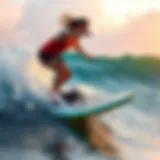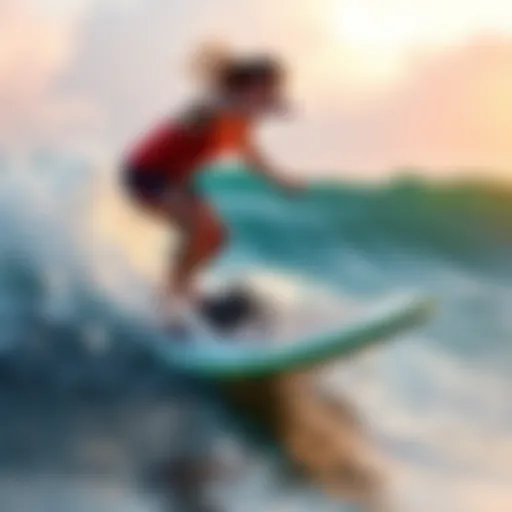The Role of Frontwings in Kiteboarding Performance


Intro
Kiteboarding has taken the outdoor world by storm, evolving from a quirky pastime into a highly skilled sport. At the heart of this activity lies the frontwing, a component often overshadowed by other gear but crucial for enhancing performance and maneuverability. This article seeks to peel back the layers of frontwings, shedding light on their intricate design, functionality, and impact on the overall kiteboarding experience. Whether you're a novice or a seasoned rider, understanding the role of frontwings can make a significant difference in both your technique and enjoyment of the sport.
Gear and Equipment
In the realm of kiteboarding, the right gear can spell the difference between a lackluster experience and a thrilling adventure. Frontwings are among the most pivotal pieces of equipment, directly influencing how a rider interacts with the water and harnesses the wind.
Essential Kiteboarding Gear: A Comprehensive Guide
To excel in kiteboarding, you need more than just a kite and a board. Here’s a rundown of essential equipment:
- Kite: The lifeblood of kiteboarding, available in various shapes and sizes, tailored for different wind conditions and riding styles.
- Board: In tandem with a suitable frontwing, the board enhances control and stability. Consider the dimensions and weight for the best fit.
- Frontwing: This is where the magic happens. Select a frontwing that aligns with your riding style—smaller wings offer agility, while larger wings provide lift at lower speeds.
- Harness: Proper support while riding is non-negotiable. Choose between seat or waist harnesses based on comfort and style preferences.
- Safety Gear: A helmet and impact vest can save you from nasty spills. Safety first, always.
Maintenance Tips for Kiteboarding Equipment
Keeping your gear in prime condition is essential for longevity and performance. Here are a few maintenance tips to consider:
- Regular Cleaning: Rinse your frontwing and kite with fresh water after every session. Saltwater can degrade materials over time.
- Inspect for Damage: Before each outing, check for tears, cracks, or other signs of wear. It’s better to catch small issues before they develop into big problems.
- Proper Storage: Avoid leaving equipment exposed to harsh sun or extreme temperatures. A temperature-controlled environment is ideal.
- Wing Maintenance: Inspect the foil for delamination or scratches, as this can affect performance.
"A well-maintained frontwing not only enhances performance but also prolongs your kiteboarding journey."
Techniques and Skills
Gaining proficiency in kiteboarding involves more than just understanding your equipment; it’s about mastering your skills on the water.
Beginner Techniques to Get Started with Kiteboarding
For those dipping toes into the sport, the basics are vital. Focus on the following:
- Body Positioning: Maintaining a balanced stance on the board will help with control and maneuverability.
- Edge Control: Learn to use the edges of your board to generate speed and navigate effectively.
Advanced Maneuvers for Seasoned Kiteboarders
As you progress, the focus shifts to refining skills and integrating frontwing techniques:
- Carving Turns: Use your frontwing knowledge to execute smoother, more controlled turns.
- Jumping Techniques: The right frontwing can aid in getting the most out of your jumps, enhancing both height and stability. For aspiring pros, practicing is key.
Ending
The exploration of frontwings in kiteboarding unveils the beauty of technical precision and the art of riding. Understanding the nuances of your gear, especially the frontwing, can dramatically improve trajectory and performance on the water. Trust this guide will not only elevate your skills but also deepen your appreciation for the dynamic world of kiteboarding. For further information, you can check out resources like Wikipedia and Britannica for detailed insights.
Understanding Frontwings
Frontwings are an essential component of kiteboarding gear that significantly impact a rider's ability to perform and maneuver. They are the unsung heroes in a kiteboarder's setup, responsible for providing lift, stability, and control while navigating diverse water conditions. Understanding the technicalities of frontwings can help riders choose the right equipment tailored to their specific style and requirements, fostering both safety and performance on the water.
Definition and Purpose
Frontwings act as the primary lifting surface of a kiteboard setup. Positioned at the front of the board, their design influences how the board interacts with the water, affecting factors like speed, agility, and overall responsiveness. The primary purpose of a frontwing is to convert the kite's pull into upward lift, enabling the rider to stay afloat while adjusting angles for optimal speed and maneuverability. In simpler terms, you could see the frontwing almost as a hand guiding the board through the air and water, balancing power and finesse with each move.
Additionally, frontwings play a crucial role in different riding styles. Whether you are freeriding, freestyle, or racing, the characteristics of the frontwing can make all the difference. A well-designed frontwing helps riders maintain control, adapt to shifting conditions, and even perform tricks with greater ease. Thus, knowing how various design elements—such as shape, size, material, and weight—come into play can offer vital insights into improving one’s kiteboarding experience.
The Evolution of Frontwings
The development of frontwings has seen remarkable changes over the years, paralleling advances in kiteboarding technology itself. Originally made from rigid shapes and basic materials, early frontwings provided the essential lift needed to skim across water but lacked sophistication in design. As the sport evolved, so did the frontwings. New manufacturing techniques and materials have allowed for innovations that offer enhanced performance.
The introduction of lighter composites and aerodynamic shapes represented a significant leap in frontwing design. For example, the shift from heavier fiberglass to modern carbon fiber has not only decreased weight but improved durability and responsiveness. Nowadays, frontwings are designed with specific riding styles in mind, offering tailored performance traits that appeal to both casual riders and competitive professionals. The nuances of shape and size—ranging from larger, wider wings that provide better lift at low speeds to smaller wings ideal for speed and tricks—reflect the diverse needs of kiteboarding enthusiasts.
In recent years, sustainability has also entered the conversation surrounding frontwing development. Manufacturers are looking to eco-friendly materials, ensuring that as kiteboarding continues to grow in popularity, it does so with an eye on environmental impact. This constant evolution ensures that frontwings remain at the forefront of kiteboarding experiences, enabling riders to push boundaries while enjoying the sport more than ever.
"The right frontwing can transform your riding experience from ordinary to extraordinary, making it essential to understand their capabilities."
Design Features of Frontwings
When kiteboarding, the design of frontwings can make or break a session. Having a clear grasp of design features is crucial because it influences performance, maneuverability, and even rider comfort. Everything from the shape to the materials used can significantly affect how a kiteboard responds on the water, dictating not just speed, but overall experience.
Shape and Size Considerations
The shape and size of a frontwing are pivotal in shaping its functionality. Typically, a larger surface area provides more lift, making it easier for riders to get up on the board. However, a large wing can also create more drag, which might hinder speed. That said, flatter wings tend to excel in stability, whereas curved wings can enhance maneuverability. A common misconception is that bigger is always better; it’s not!
Another factor to consider is the aspect ratio. High aspect ratio wings, which are long and narrow, are designed for speed and efficiency, while lower aspect ratio wings tend to be more stable and easier to control. Choosing the right shape and size requires a good knowledge of one's riding style and the conditions one typically faces.
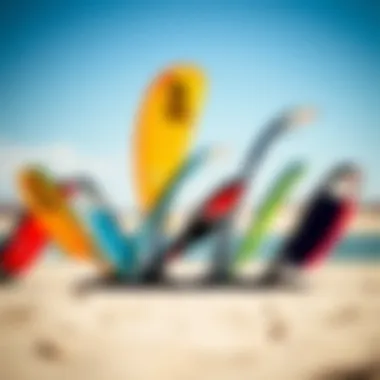

Material Composition
Next up on the list is how the materials used in construction play a significant role in the overall quality and performance of frontwings. Materials can range from fiberglass to carbon fiber, and each has its pros and cons. Carbon fiber is lightweight and offers rigidity, which translates to better responsiveness and speed. It’s what many competitive riders prefer, but it also comes with a heftier price tag. On the other hand, fiberglass is more affordable and provides decent performance with a bit more flex, making it less harsh on the knees over choppy waters.
Additionally, some manufacturers are experimenting with eco-friendly materials to reduce their carbon footprint. This is increasingly becoming a selling point for environmentally-conscious consumers, showing that the industry is evolving.
Weight and buoyancy
Weight plays a crucial role in how a frontwing behaves on the water. Lighter wings tend to lift off more easily, allowing for quicker acceleration. However, excessive lightness can also lead to a lack of stability, especially in choppy conditions. Thus, balance is key. Designers strive to find a happy medium between weight and strength to ensure the rider has ample buoyancy without compromising control.
A well-designed frontwing should be buoyant enough to support the rider's weight without submerging too deeply into the water. This buoyancy affects how quickly a kiteboard can take off and how smoothly it can land.
Ultimately, understanding the intricacies of design features can help riders tailor their equipment to their specific needs, ensuring not just a thrill on the water, but a safer experience, too.
"A kiteboarder's experience is not solely built on skill, but also on the thoughtful selection of equipment that interacts harmoniously with the elements."
For more in-depth exploration on these concepts, check out resources like Wikipedia or Britannica. Join discussions on platforms like Reddit to get insights from fellow enthusiasts.
Types of Frontwings
In kiteboarding, the choice of frontwings plays a pivotal role in shaping the rider's experience on the water. Each type of frontwing is designed with specific purposes and riding styles in mind, which can drastically influence performance, stability, and overall maneuverability. Whether you're a seasoned pro or a novice, understanding these nuances can lead to better decision-making when it comes to gear selection. Different frontwings will offer varying levels of lift, speed, and control, affecting how well you can perform tricks, cruise freely, or navigate challenging conditions.
Freeride Frontwings
Freeride frontwings are tailored for versatility, making them an excellent option for riders who value a balanced experience. These wings usually have a forgiving shape that suits a wide range of skill levels, allowing for both smooth cruising and occasional jumps. Ideal for those who aim to enjoy a laid-back session while still having the ability to push the limits, freeride frontwings generally feature a moderately sized surface area.
"The right freeride wing can turn a simple day out into a memorable adventure on the water."
These wings are typically characterized by:
- Size: Moderate sizing that promotes stability without sacrificing speed.
- Lift: Offers consistent lift, enabling casual riders to enjoy the thrill of flying without feeling overly challenged.
- Control: High levels of maneuverability aid in learning new techniques, allowing for progression in skill.
Freestyle Frontwings
For the adventurous souls drawn to tricks and jumps, freestyle frontwings are a perfect match. These wings are designed for optimal performance in aerial maneuvers. With a unique shape that emphasizes lift and pop, freestyle frontwings allow riders to launch high and perform complex tricks. They often feature a shorter span, making them nimble and conducive to quick turns.
Factors to consider when opting for freestyle frontwings include:
- Pop: Enhanced lift capabilities make it easier to execute jumps and aerial tricks.
- Precision: Quick response during turns, allowing for sharp maneuvers mid-air.
- Durability: Often constructed from robust materials to withstand the rigors of repeated impacts and landings.
Wave Riding Frontwings
Wave riding enthusiasts will find that specialized wings for this modality cater to their urge for adventure. Wave riding frontwings are designed for handling the dynamic and unpredictable nature of ocean waves. They generally feature a unique profile, maximizing control and stability while enhancing the overall surfing experience.
Critical considerations for wave riding frontwings are:
- Shape: A thinner profile with a slightly pointed nose minimizes drag while maximizing speed on the wave face.
- Stability: Ensures that the rider maintains control even in choppy conditions, providing a calming ride.
- Turnability: Allows for smooth arcs and transitions, essential when navigating through barrels or carving around waves.
Race and Competition Frontwings
Racing demands precision, speed, and efficiency, making race and competition frontwings a unique breed in the kiteboarding realm. These wings are engineered for maximum performance during competitive events, incorporating cutting-edge technology and design features to optimize speed and control. Key elements of race frontwings often include:
- Streamlined Design: The overall shape reduces drag and enhances lift, enabling faster movement across the water.
- Efficiency: The ability to maintain speed with less effort is a crucial factor, ensuring riders can sustain their performance throughout lengthy races.
- Customization: Many race frontwings can be tailored to the individual rider’s preferences, enhancing their competitive edge.
Understanding the various types of frontwings not only enriches your knowledge but also empowers you to make informed decisions when gearing up. As each type carries distinct characteristics, aligning your selection with your personal riding style and objectives will ultimately maximize your kiteboarding experience.
Performance Metrics Associated with Frontwings
Understanding performance metrics is crucial for kiteboarders aiming to enhance their experience on the water. These metrics provide vital information about how well a frontwing functions under varying conditions, influencing ride quality, stability, and control dynamics. In essence, knowing how lift, drag, stability, and speed interrelate can help kiteboarders make informed decisions about the right frontwing for their style.
Lift and Drag Ratios
Lift and drag ratios are the bread and butter of kiteboarding performance. A frontwing’s lift refers to its ability to support the rider's weight and keep them afloat. Drag, on the other hand, is the resistance faced by the wing as it moves through the water. Ideally, a kiteboarder wants a wing that generates high lift with minimal drag.
Specifically, a frontwing that achieves a favorable lift-to-drag ratio allows for smoother rides. This ratio can significantly impact how well a rider can glide across the water, especially when they’re pushing the limits of speed or maneuverability. For instance, a frontwing designed for freeriding might have a greater emphasis on lift to get the rider out of the water with less effort, while a wing meant for racing could focus more on reducing drag to maximize speed.
In practice, kiteboarders may find themselves checking these ratios through hands-on experience and comparisons between different frontwings. A good starting point for evaluating these metrics is comparing wings side by side and noting the differences in their performance under similar conditions.
Stability and Control
Stability is paramount when it comes to kiteboarding. A rider depends on the frontwing’s ability to remain steady and predictable in various conditions. Control goes hand-in-hand with this stability; it’s about how easily the rider can maneuver without losing balance.
Different shapes, sizes, and features contribute to a frontwing’s stability. For example, wider wings offer more surface area, translating to enhanced stability, especially in choppy waters. Conversely, narrower wings can be more agile, perfect for quick turns and tricks but may demand more skill from the rider.
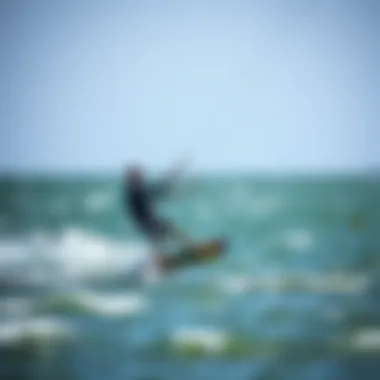

To experiment with these aspects, many riders utilize the responsiveness of their wings by testing them out in different environments. Windsurfing forums often provide insights into rider experiences, allowing enthusiasts to tap into the collective wisdom about stability characteristics of various wings.
Speed and Agility Enhancements
Speed and agility are often what draw kiteboarders into the sport. Gaining the competitive edge means understanding how frontwings can enhance acceleration and sharpness during turns. A wing that allows for quicker response times can make all the difference, especially in competitive settings.
Frontwings tailored for speed tend to have characteristics such as a pointed tip and streamlined edges. This design facilitates better airflow, minimizing turbulence and maximizing speed. Additionally, lightweight materials contribute to the sprint, allowing more acceleration with less effort.
On the agility front, kiteboarders should look for features that permit sharp turns and quick redirects. Some wings cater specifically to freestyle riding, where agility is essential for executing tricks and jumps. Riders often find that the right frontwing can transform their performance, providing a significant advantage when trying out new maneuvers.
"Understanding the metrics related to your frontwing can dramatically improve your control and enjoyment."
In summary, performance metrics related to frontwings encompass more than just numbers – they shape the entire kiteboarding experience. By grasping these fundamentals, kiteboarders can tailor their gear to their personal style, challenges, and preferences.
Selecting the Right Frontwing
Choosing the right frontwing is pivotal for any kiteboarding enthusiast looking to optimize performance while ensuring comfort and control on the water. The right wing can mean the difference between a thrilling ride and a less than ideal experience. By focusing on specific elements such as rider skill level, preferred riding style, and environmental conditions, one can make informed decisions to enhance their time out on the waves. Gaining a comprehensive understanding of these aspects can elevate one's kiteboarding experience significantly.
Assessing Rider Skill Level
Understanding where a rider stands in terms of skill levels—be it a beginner, intermediate, or expert—significantly influences their choice of frontwing. Each category typically calls for different wing specifications to align with the rider’s abilities, ensuring safety and performance.
- Beginners often benefit from larger frontwings. These wings offer better stability and lift at slower speeds, providing a reassuring experience as one is still mastering their skills. A larger surface area helps prevent the rider from sinking and promotes confidence, allowing them to focus on fundamental techniques.
- Intermediate riders might experiment with a medium-sized wing that offers a balance between control and speed. This stage is all about refining skills, and a moderate wing can assist with smoother transitions while encouraging riders to push their capabilities.
- For advanced kiteboarders, smaller frontwings usually come into play. They are designed for agility and speed, allowing for dynamic aerial tricks and sharp turns. The trade-off here is that they demand a higher level of experience and input from the rider to maintain control, especially in challenging conditions.
"Selecting the right frontwing can unlock potential that a rider might not even realize they possess."
Matching Frontwing for Riding Style
Every kiteboarder has a unique riding style shaped by personal preferences and riding intentions. Understanding this facet is crucial when selecting the appropriate frontwing. Different types of riding might require different wing designs to maximize enjoyment:
- Freeride styles often call for wings that prioritize stability and smooth gliding. Riders looking to cruise leisurely over flat waters should opt for wider wings that enhance lift in all conditions.
- Freestyle riders tend to prefer wings providing greater maneuverability, allowing for spins or jumps. A wing that can handle high speeds and quick turns while also giving enough lift for aerial maneuvers is essential in these scenarios.
- Wave riders require specific characteristics from their wings to handle the unpredictability of ocean waves. A responsive and compact wing helps in making quick adjustments while surfing over the swells. These riders seek agility, needing wings that enable sharp turns and quick reactions.
- Racers look for speed. Wings suited for competition tend to be more streamlined and less forgiving. They are designed for maximizing speed on nice breezy days when every ounce of lift and drag must be controlled.
Adapting to Environmental Conditions
The wind and water conditions play a major role in determining the best frontwing choice. Different environments call for different adaptations:
- In light wind conditions, larger frontwings are advisable. They create more lift, allowing riders to stay afloat without extreme effort. This can be quite the blessing when trying to catch those gentle breezes.
- For high winds, smaller wings better suit the conditions. They tend to provide less drag and help maintain more control at increased speeds. This adjustment is critical for those who want to avoid being overpowered by the kite.
- Choppy waters may require a durable frontwing that can withstand the impact. Choosing a wing with a robust build and designed for stability will help mitigate the challenges posed by turbulent water.
- If navigating through harsh conditions like storms or extreme currents, selecting frontwings tailored for resilience becomes paramount. These wings often feature reinforced materials to enhance durability against wear and tear.
In summary, selecting the right frontwing is not merely about picking a sleek design; it encompasses understanding the intersections between skill, style, and situational factors. By navigating these considerations would-be kiteboarders can set themselves up for exhilarating experiences on the water, pushing the limits of their capabilities.
Maintenance Practices for Frontwings
Maintaining frontwings is essential for ensuring optimal performance in kiteboarding. These components are critical for lift, stability, and overall maneuverability. Regular upkeep not only prolongs the life of the frontwings but also enhances rider experience by maximizing their effectiveness. Neglecting maintenance can lead to diminished performance or even damage, which can hinder the fun and thrill that kiteboarding brings.
Cleaning and Care
Keeping frontwings clean is a straightforward yet vital task. After each session on the water, rinsing the wings with fresh water is a good habit. This simple action helps to remove salt, sand, and other debris that can accumulate and potentially cause wear and tear over time.
To properly clean the wings:
- Use a soft cloth or sponge to gently scrub the surfaces. Avoid abrasive materials that could scratch the finish.
- Pay particular attention to the edges and any grooves where dirt might accumulate.
- For deeper cleaning, a mild soap solution can be beneficial; however, be sure to wash it off thoroughly afterward.
Regular cleaning not only maintains appearance but also optimizes aerodynamic performance by reducing drag.
Inspecting for Damage
Every kiteboarder knows that the conditions on the water can be unpredictable. Thus, making it a point to inspect the frontwings after every usage is crucial. Small nicks, cracks or delaminations can develop from impacts or prolonged exposure to harsh conditions. Here’s how to conduct a good inspection:
- Visually scan the frontwing for any visible dents or scratches.
- Run your hands over the surfaces to feel for any irregularities.
- Check the mounting points and ensure there are no loose screws or hardware.
"A stitch in time saves nine," and this stands true when it comes to maintaining your equipment.
Addressing minor issues early can prevent more significant problems down the line. If any damage is spotted, it’s best to consult with the manufacturer or a professional for repairs.
Storage Recommendations
Storing frontwings correctly is just as critical as cleaning and inspecting them. Proper storage helps shield the wings from environmental damage and physical stress. Here are some tips for keeping them in prime condition:
- Avoid storing in direct sunlight as UV rays can degrade materials over time.
- Use padded bags specifically designed for kiteboarding gear to protect the wings from impacts.
- Store in a cool, dry location to prevent mildew and ensure dry materials.
When traveling, ensure that the wings are properly secured and cushioned, especially if packed with other gear.
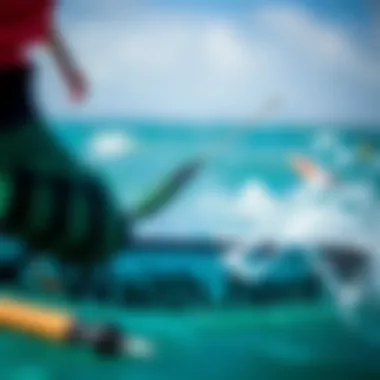

The Future of Frontwing Technology
Advancements in frontwing technology play a pivotal role in the ongoing evolution of kiteboarding. This section looks beyond current designs, emphasizing the significance of innovation in enhancing performance and maneuverability on the water. The development of new materials, shapes, and functionalities can not only improve efficiency but also cater to the various riding styles and conditions that kiteboarders face.
To put it simply, the future of frontwings is not just about making good gear—it's about creating the best possible experience for riders. As participants in this sport demand more versatility and higher performance levels, manufacturers are pushed to explore uncharted territories.
Innovations in Design
One of the most exciting aspects of frontwing development lies in the innovative designs emerging from research and real-world testing. Manufacturers are experimenting with geometries that optimize lift and minimize drag, enabling riders to harness wind energy more efficiently. For instance, adaptive wing shapes have gained traction, allowing frontwings to alter their profiles during use.
Here's a glimpse of some notable design innovations:
- Variable Aspect Ratios: Some frontwings are now designed with adjustable aspect ratios. This adaptability allows for better performance under changing wind conditions, providing stability without sacrificing speed.
- Integrated Systems: New designs may incorporate integral systems like flaps or slots, which dynamically alter the airflow over the wing, enabling sharper turns and smoother rides.
- Customizable Features: Enhanced customization in design allows riders to tweak their gear according to personal preferences and local conditions, often resulting in a significant performance boost.
The ongoing push for stronger, lighter, and more efficient designs ensures that kiteboarding remains a cutting-edge sport, continually evolving to meet rider needs.
Adoption of Eco-friendly Materials
Sustainability is a pressing concern across many industries, and kiteboarding is no exception. As manufacturers strive to create more environmentally friendly products, the adoption of eco-friendly materials is becoming increasingly crucial in frontwing development.
Using sustainable materials doesn't just help the planet; it can also enhance the characteristics of frontwings. Here are some trends worth noting:
- Biodegradable Composites: These materials, made from natural fibers or resins, can provide excellent performance while minimizing environmental impact after their lifecycle ends.
- Recycled Plastics: Innovations in processing have made it possible to utilize recycled plastics in frontwing production, thus reducing waste and the energy needed for production.
- Sustainable Production Processes: Manufacturers are now considering the entire lifecycle of a product—from sourcing to end-of-life disposal—ensuring their practices align with eco-conscious principles.
"The future of kiteboarding is not just on the water, but also in how we treat the planet we ride on."
Embracing eco-friendly materials shows an industry commitment not only to performance but also to environmental stewardship. As kiteboarding enthusiasts become more aware of their impact on the environment, using sustainable materials will likely influence purchasing decisions, paving the way for a more responsible future.
In summary, the future of frontwing technology is bright. Through continual innovation in design and material choices, kiteboarding can evolve to become more efficient, versatile, and sustainable. As we look ahead, it’s essential to keep a close eye on these developments, as they will undoubtedly shape the riding experiences of tomorrow.
Frontwings in Competitive Settings
In the fast-paced arena of kiteboarding, where milliseconds can determine the difference between victory and defeat, the importance of frontwings in competitive settings cannot be overstated. The type of frontwing a competitor chooses affects not merely their speed but also stability, maneuverability, and overall race strategy. Competitive kiteboarding requires not only skill and focus but also meticulous equipment choices. In such contexts, the role of the frontwing extends well beyond mere functionality—it becomes a pivotal player in the dynamics of the competition.
Analyzing Race Performance
When it comes to high-stakes races, analyzing performance becomes crucial. Frontwings have a profound influence on how a kiteboarder interacts with wind conditions and water surfaces. A frontwing designed for speed, for example, may have a slimmer profile and reduced surface area. This design can minimize drag but might also compromise lift at lower speeds. Conversely, a wider frontwing increases lift capabilities, allowing for smoother performance in choppy waters, but it can be cumbersome during rapid maneuvers.
In competitive settings, high-performance riders need to gauge their frontwing’s lift-to-drag ratio. This ratio is measured using precision instruments during training sessions, and it provides insights into how effectively a frontwing can harness wind energy.
For instance, consider a professional competition at the Kiteboarding World Cup. Riders with knowledge of their frontwings’ characteristics might adjust their approach based on current assets:
- Using larger frontwings: During a race with light winds, a competitor might select a larger wing to enhance lift, allowing them to ride higher and maintain momentum.
- Opting for smaller wings: In high-wind conditions, a smaller frontwing might enable faster speeds and quick directional changes, critical for overtaking other competitors.
The ability to analyze race performance through frontwing technology equips riders to adapt to rapidly changing conditions.
Comparative Case Studies
To illustrate the effect of frontwings in competitive settings, consider a couple of case studies that shed light on rider choices during various competitions.
- Case Study of the 2022 Kitesurf World Championship
- Local Tournaments vs. International Events
- Rider A: Opted for a lightweight carbon fiber frontwing, which offered excellent speed but struggled during crosswinds, leading to a mid-pack finish.
- Rider B: Selected a hybrid frontwing combining durability with aerodynamics, who despite not having the fastest top speed, showcased impressive control and won the championship due to superior handling.
- In local tournaments, many riders choose all-around frontwings that are user-friendly and forgiving during less-than-ideal conditions. A study of participant feedback revealed that adaptability was valued over specialized performance. Conversely, international races emphasized cutting-edge technology, with riders gravitating towards high-performance wings tailored to specific conditions, showcasing how competition level influences frontwing choices.
Through such case studies, one can glean important insights into the balance between individual rider preferences, environmental conditions, and equipment specifications, underscoring the significance of strategic planning in competitive kiteboarding.
Community Perspectives on Frontwings
When it comes to kiteboarding, the equipment often speaks louder than the rider. Among the various components, frontwings play an essential role in not just performance but also in the shared experience of the kiteboarding community. Engaging with fellow riders provides valuable insight into trends, preferences, and innovations in frontwing technology.
Riding styles evolve, and so do the preferences for different frontwings. Kiteboarders often swap notes on the nuances of their gear, discussing what works best for them in various conditions. This exchange of ideas sheds light on how specific frontwing features resonate differently among riders.
"When you’re out there on the water, the right frontwing makes all the difference. It’s not just about speed, it's about feeling connected with your kite and board."
— Local Kiteboarder, Jamie
Rider Experiences and Feedback
Rider feedback is often the backbone of community discussions. A kiteboarder’s first-hand experience can provide insights that product specifications might not reveal. For instance, a freeride enthusiast may comment on how a certain model performs well during choppy conditions, while a freestyle kiteboarder might emphasize how lighter wings improve maneuverability during tricks.
- Real-life Scenarios: Riders often share their stories, detailing how different frontwings impacted their performance. These narratives not only celebrate triumphs but also serve as cautionary tales about compatibility and skill level.
- Personal Recommendations: Sometimes, a rider will mention a specific brand that helped them achieve their goals, and that can drive fellow enthusiasts to investigate further. It's this flow of constructive criticism and praise that enriches the community's knowledge base.
Sharing experiences in riding groups or on social media platforms like Facebook or Reddit can lead to new connections and learning opportunities. Such shared stories lead to a deeper understanding of the relationship between rider style and equipment choice.
Forums and Discussion Boards
Online forums and discussion boards act as digital town squares for kiteboarders. These platforms are invaluable for disseminating up-to-date knowledge on frontwing technology, gear recommendations, and troubleshooting. Participating in these discussions allows enthusiasts to engage actively with the community.
- Exchange of Ideas: Posts on platforms such as Reddit can generate extensive threads discussing various frontwing models. Questions arise about weight distribution, responsiveness, or adaptability to different weather conditions, leading to healthy debates.
- Q&A Threads: Many forums feature sections where newcomers can ask for advice on their first purchases. Experienced riders freely share their thoughts, often pointing out what to consider when selecting a frontwing.
- Product Reviews: Dedicated threads for product reviews allow users to post their experiences, which others can read before making an investment.


